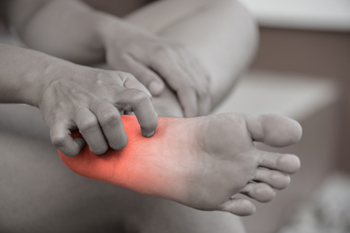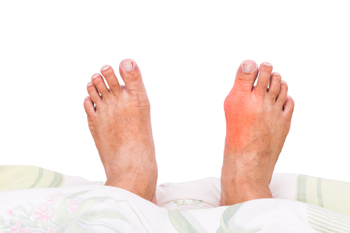Items filtered by date: October 2023
Peripheral Neuropathy and Its Impact on Feet

Peripheral neuropathy is a complex condition that affects the peripheral nervous system, leading to a range of symptoms that can significantly impact the feet. This disorder results from damage to the nerves outside the brain and spinal cord, often caused by various underlying conditions such as diabetes, infections, or autoimmune diseases. When it affects the feet, individuals may experience numbness, tingling, or a sensation of pins and needles. This can progress to sharp, shooting pain and muscle weakness. As the condition advances, it can lead to a loss of balance and coordination, increasing the risk of falls. The feet may also become more susceptible to injuries, blisters, and ulcers, with a reduced ability to detect pain or discomfort. Managing peripheral neuropathy often involves addressing the underlying cause, along with pain management and lifestyle adjustments. If you have symptoms of neuropathy, it is suggested that you schedule an appointment with a podiatrist who can perform routine foot exams which may help to prevent potential complications.
Neuropathy
Neuropathy can be a potentially serious condition, especially if it is left undiagnosed. If you have any concerns that you may be experiencing nerve loss in your feet, consult with Jim Maxka, DPM from South Penn Foot & Ankle Associates. Our doctor will assess your condition and provide you with quality foot and ankle treatment for neuropathy.
What Is Neuropathy?
Neuropathy is a condition that leads to damage to the nerves in the body. Peripheral neuropathy, or neuropathy that affects your peripheral nervous system, usually occurs in the feet. Neuropathy can be triggered by a number of different causes. Such causes include diabetes, infections, cancers, disorders, and toxic substances.
Symptoms of Neuropathy Include:
- Numbness
- Sensation loss
- Prickling and tingling sensations
- Throbbing, freezing, burning pains
- Muscle weakness
Those with diabetes are at serious risk due to being unable to feel an ulcer on their feet. Diabetics usually also suffer from poor blood circulation. This can lead to the wound not healing, infections occurring, and the limb may have to be amputated.
Treatment
To treat neuropathy in the foot, podiatrists will first diagnose the cause of the neuropathy. Figuring out the underlying cause of the neuropathy will allow the podiatrist to prescribe the best treatment, whether it be caused by diabetes, toxic substance exposure, infection, etc. If the nerve has not died, then it’s possible that sensation may be able to return to the foot.
Pain medication may be issued for pain. Electrical nerve stimulation can be used to stimulate nerves. If the neuropathy is caused from pressure on the nerves, then surgery may be necessary.
If you have any questions, please feel free to contact our office located in Hanover, PA . We offer the newest diagnostic and treatment technologies for all your foot care needs.
The Development of a Bunion

Bunions, a common foot condition, can cause significant discomfort and affect daily life. Understanding the causes behind their development is important in finding effective preventive measures and treatments. Often, bunions are inherited, as a result of genetic factors influencing foot structure and mechanics. Wearing tight or ill-fitting shoes, especially those with pointed toes or high heels, can exert pressure on the toes and contribute to bunion formation. Foot stress and overuse, commonly seen in athletes or individuals with occupations that require prolonged standing, can also aggravate bunions. Additionally, medical conditions such as arthritis may increase the risk of developing bunions. Gender plays a role, with women being more susceptible due to wearing footwear that cramps the toes. Recognizing these causes empowers individuals to make informed choices regarding footwear and foot care. If you have a bunion, it is suggested that you are under the care of a podiatrist who can help you to manage this condition, and offer potential relief options.
If you are suffering from bunion pain, contact Jim Maxka, DPM of South Penn Foot & Ankle Associates. Our doctor can provide the care you need to keep you pain-free and on your feet.
What Is a Bunion?
Bunions are painful bony bumps that usually develop on the inside of the foot at the joint of the big toe. As the deformity increases over time, it may become painful to walk and wear shoes. Women are more likely to exacerbate existing bunions since they often wear tight, narrow shoes that shift their toes together. Bunion pain can be relieved by wearing wider shoes with enough room for the toes.
Causes
- Genetics – some people inherit feet that are more prone to bunion development
- Inflammatory Conditions - rheumatoid arthritis and polio may cause bunion development
Symptoms
- Redness and inflammation
- Pain and tenderness
- Callus or corns on the bump
- Restricted motion in the big toe
In order to diagnose your bunion, your podiatrist may ask about your medical history, symptoms, and general health. Your doctor might also order an x-ray to take a closer look at your feet. Nonsurgical treatment options include orthotics, padding, icing, changes in footwear, and medication. If nonsurgical treatments don’t alleviate your bunion pain, surgery may be necessary.
If you have any questions, please feel free to contact our office located in Hanover, PA . We offer the newest diagnostic and treatment technologies for all your foot care needs.
Guide to Running During Pregnancy

In the past, it was often believed that pregnancy meant complete bed rest, but times have changed. Medical advice now emphasizes the importance of staying active during pregnancy. This shift has led many expectant mothers to wonder if it is safe to continue running while pregnant. The short answer is yes, you can continue running during pregnancy, but it comes with some considerations. If you were an avid runner, you may be able to continue with certain modifications. However, as your due date approaches, transitioning to lower-impact activities like walking or swimming is thought to be a wiser choice. Running offers numerous benefits during pregnancy, such as reducing the risk of pre-eclampsia and gestational diabetes, maintaining a healthy body weight, and improving overall well-being. However, if you experience dizziness, vaginal bleeding, breathing difficulties, or foot and ankle pain, stop running immediately and seek medical attention. While running during pregnancy can be safe and beneficial, it requires careful consideration and consultation with your medical team. If you experience foot pain after running during pregnancy, it is suggested that you make an appointment with a podiatrist.
Pregnant women with swollen feet can be treated with a variety of different methods that are readily available. For more information about other cures for swollen feet during pregnancy, consult with Jim Maxka, DPM from South Penn Foot & Ankle Associates. Our doctor will attend to all of your foot and ankle needs.
What Foot Problems Can Arise During Pregnancy?
One problem that can occur is overpronation, which occurs when the arch of the foot flattens and tends to roll inward. This can cause pain and discomfort in your heels while you’re walking or even just standing up, trying to support your baby.
Another problem is edema, or swelling in the extremities. This often affects the feet during pregnancy but tends to occur in the later stages.
How Can I Keep My Feet Healthy During Pregnancy?
- Wearing orthotics can provide extra support for the feet and help distribute weight evenly
- Minimize the amount of time spent walking barefoot
- Wear shoes with good arch support
- Wear shoes that allow for good circulation to the feet
- Elevate feet if you experience swelling
- Massage your feet
- Get regular, light exercise, such as walking, to promote blood circulation to the feet
If you have any questions please feel free to contact our office located in Hanover, PA . We offer the newest diagnostic and treatment technologies for all your foot and ankle needs.
Arthritis Can Cause Pain in the Feet and Ankles
Plantar Fibromatosis

The plantar fascia is a thick fibrous tissue in the foot that helps maintain the arch. Plantar fibromas typically affect the medial and central bands of the plantar fascia. This condition, also known as Ledderhose disease, is rare and is characterized by the formation of nodules on the plantar fascia of the foot. It is more common in middle-aged men and can be associated with other fibrous tissue disorders. These nodules can cause pain and even disability. Diagnosis is primarily clinical, but imaging tests such as an MRI and ultrasound can be helpful. Treatment options include conservative measures and surgical intervention. Symptoms include slow growing nodules on the arch of the foot, which can become painful and affect walking. Physical examination is essential for diagnosis, and imaging can confirm the condition. Conservative treatments include steroid injections, oral medications, radiation therapy, and extracorporeal shock wave therapy. These aim to reduce pain and nodule size. Surgical options may be considered for pain relief, but recurrence is possible. If you are suffering from any sort of foot pain, it is suggested that you make an appointment with a podiatrist for a proper evaluation and individualized treatment.
A plantar fibroma may disrupt your daily activities. If you have any concerns, contact Jim Maxka, DPM of South Penn Foot & Ankle Associates. Our doctor can provide the care you need to keep you pain-free and on your feet.
Plantar Fibroma
A plantar fibroma is a fibrous knot in the arch of the foot. It is embedded in the plantar fascia which is a band of tissue that extends from the heel to the toes along the bottom of the foot. There can be multiple plantar fibromas in the feet at the same time. There are no known causes for this condition. If you have a plantar fibroma, there will be a bump in the arch of your foot that cannot be missed. Any associated pain is most often due to a shoe rubbing against the nodule. Non-surgical options, such as steroid injections, physical therapy, and orthotics should be tried first. Surgery is a last resort and is the only thing that will remove a plantar fibroma entirely. Consult with a podiatrist for a proper diagnosis and to determine the treatment regimen that is right for you.
What Causes a Plantar Fibroma?
While there are no specific causes identified, a plantar fibroma can possibly come from genetic predisposition or the formation of scar tissue that forms from healing the tears in the plantar fascia.
What Are the Symptoms of a Plantar Fibroma?
There will be a noticeable lump in the arch of the foot that may or may not cause pain. If pain is felt, it is typically because a shoe is rubbing up against the lump or when walking or standing barefoot.
Treatment and Prevention
A plantar fibroma will not disappear without treatment, but it can get smaller and be a non-issue. If pain persists, a podiatrist examines the foot and when the arch of the foot is pressed, pain can be felt down to the toes. An MRI or biopsy might be performed to help diagnose or evaluate the plantar fibroma. The following non-surgical options are generally enough to reduce the size and pain of these nodules:
- Steroid injections
- Orthotics
- Physical therapy to help apply anti-inflammatory creams on the bump
Surgery is considered if the mass increases in size and the patient continues to feel pain after non-surgical methods are tried.
If you have any questions please feel free to contact our office located in Hanover, PA . We offer the newest diagnostic tools and technology to treat your foot and ankle needs.
The Benefits of Strengthening the Foot Muscles

When it comes to fitness, the majority of people focus on sculpting their biceps or toning their abs, often overlooking the feet, which are one of the most critical parts of the body. Foot muscle strengthening, however, offers numerous benefits that extend beyond just your feet. Strong foot muscles can enhance your balance and stability, reducing the risk of falls and injuries, in addition to contributing to better overall posture. When your feet are well-supported, it positively affects your alignment from the ground up. Strengthening the foot's arches and intrinsic muscles can also help to alleviate common foot problems such as plantar fasciitis and flat feet. Many athletes have found that stronger feet provide a solid foundation, and can improve their agility, speed, and power. Foot muscle strengthening can prevent overuse injuries that often occur due to weak or imbalanced foot muscles. Incorporating exercises consisting of toe scrunches, calf raises, and foot stretches into your routine can help you reap these benefits and maintain healthy, strong feet. If you would like to learn about how to perform specific foot stretches, it is suggested that you speak with a podiatrist who can provide you with the information you are seeking.
Exercising your feet regularly with the proper foot wear is a great way to prevent injuries and build strength. If you have any concerns about your feet, contact Jim Maxka, DPM from South Penn Foot & Ankle Associates. Our doctor can provide the care you need to keep you pain-free and on your feet.
Exercise for Your Feet
Exercise for your feet can help you gain strength, mobility and flexibility in your feet. They say that strengthening your feet can be just as rewarding as strengthening another part of the body. Your feet are very important, and we often forget about them in our daily tasks. But it is because of our feet that are we able to get going and do what we need to. For those of us fortunate enough to not have any foot problems, it is an important gesture to take care of them to ensure good health in the long run.
Some foot health exercises can include ankle pumps, tip-toeing, toe rises, lifting off the floor doing reps and sets, and flexing the toes. It is best to speak with Our doctor to determine an appropriate regimen for your needs. Everyone’s needs and bodies are different, and the activities required to maintain strength in the feet vary from individual to individual.
Once you get into a routine of doing regular exercise, you may notice a difference in your feet and how strong they may become.
If you have any questions please feel free to contact our office located in Hanover, PA . We offer the newest diagnostic and treatment technologies for all your foot and ankle needs.

